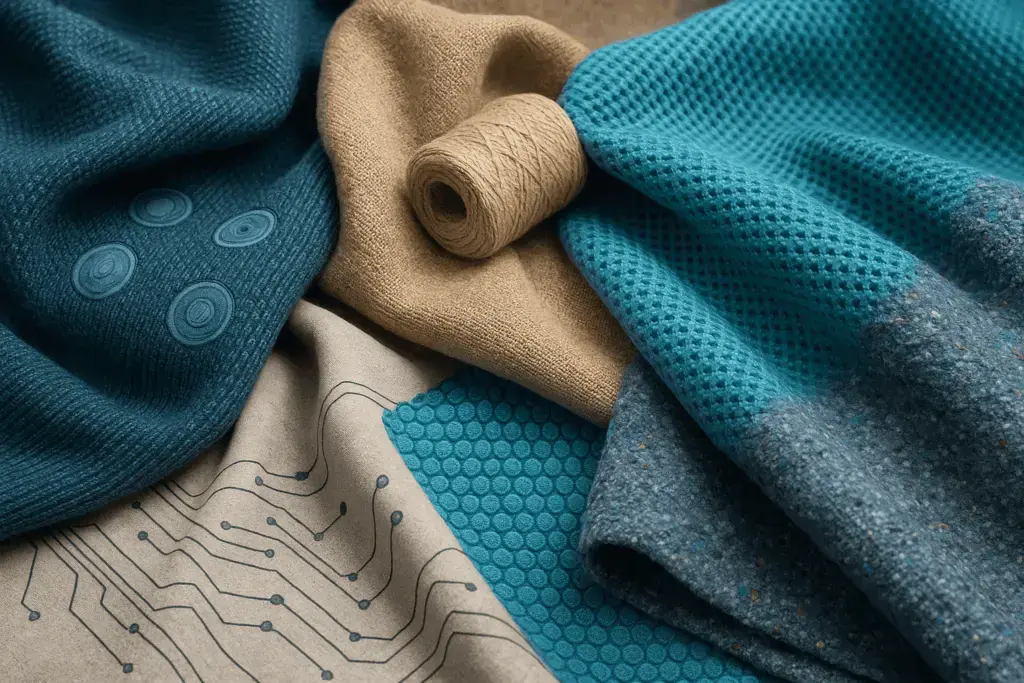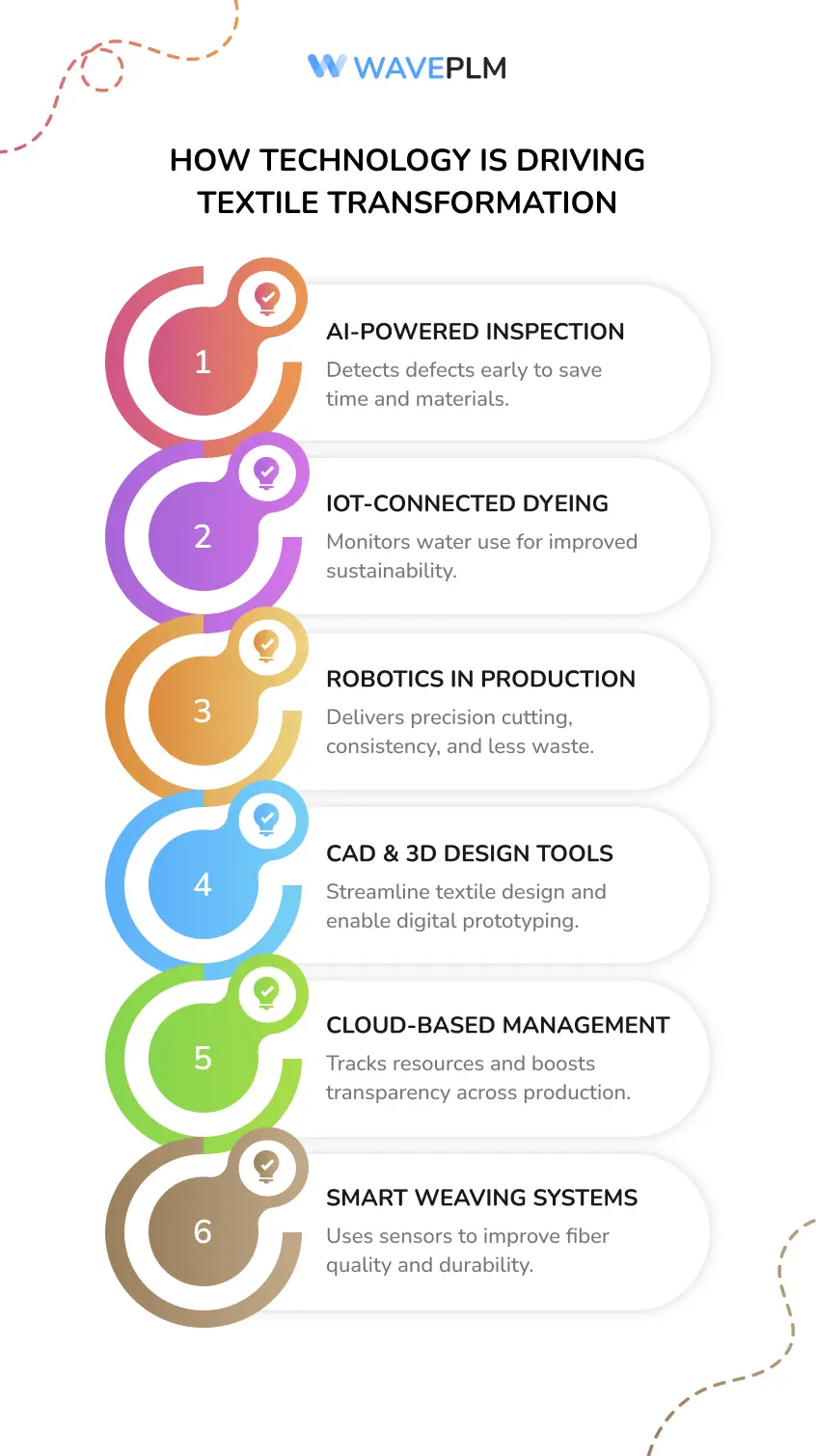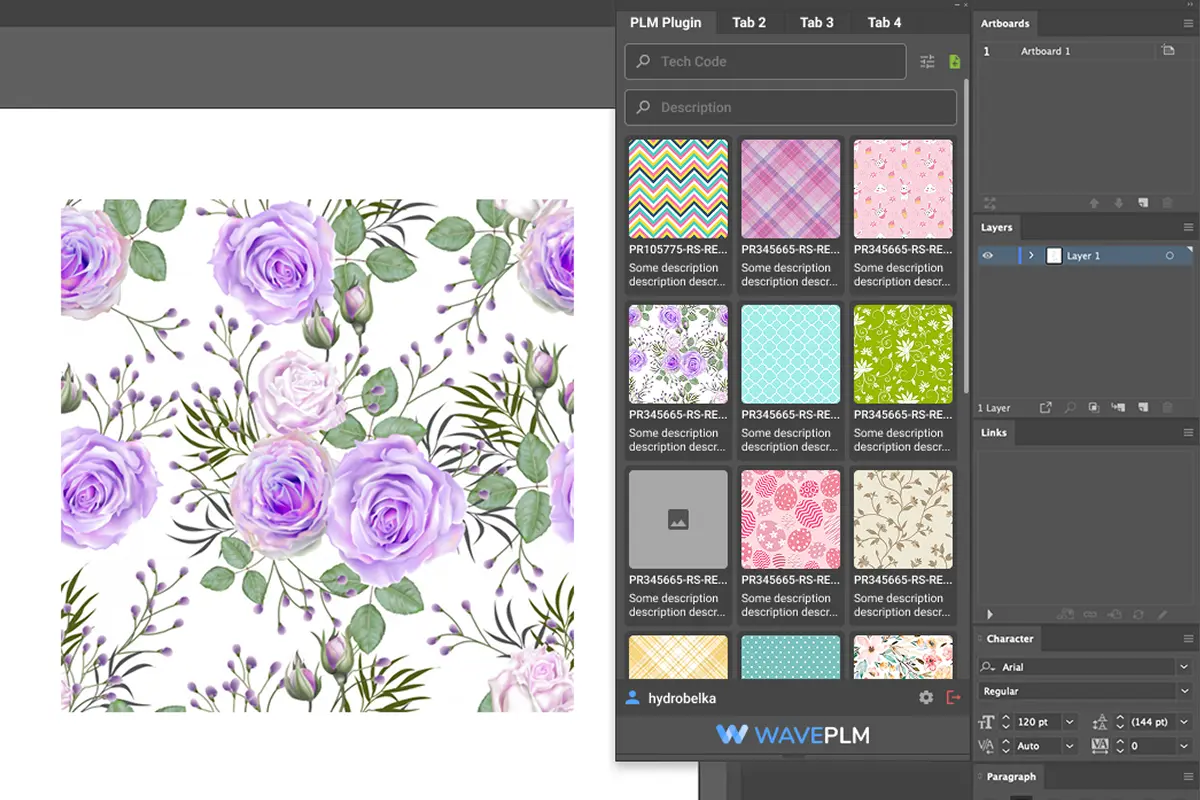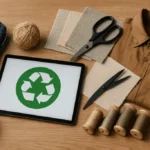
1. Introduction: The Future of Fabric Innovation
The textile industry is undergoing a transformation unlike any in its long history. Fueled by creativity, engineering, and scientific breakthroughs, this shift is redefining the way fabrics are created, designed, and used. Innovative textiles are not only changing what we wear – they are also transforming how we live, work, and connect with our environment. Modern businesses in the textile and fashion industries are adapting to new technologies and evolving consumer needs, driving this change. Every innovative textile begins with a well-defined concept, where research and brainstorming lay the foundation for development. These next-generation fabrics combine performance, functionality, and aesthetic appeal, allowing clothing to become smarter, more adaptable, and significantly more sustainable.
In the modern marketplace, textile manufacturers use advanced technologies to improve manufacturing processes, cut waste, and lower environmental impact. The expertise required by textile manufacturers and designers is essential to merge art and science in the creation of new fabrics. The growing focus on sustainable textile technology has encouraged the fashion industry to embrace materials that conserve resources, react intelligently to surroundings, and still deliver high-quality style and comfort. Whether it’s breathable activewear, self-cleaning fabrics, or biodegradable luxury fibers, the new age of textiles has arrived—and it’s reshaping every layer of the global fashion ecosystem.
From organic cotton fields to recycled polyester yarns and intricate digital printing techniques, every stage of the supply chain reflects innovation. Innovative textiles are carefully crafted, combining traditional skills with advanced technology to ensure quality and sustainability. The role of a company in sourcing or developing sustainable and innovative materials is increasingly vital. The future of textiles depends on the ability of engineers, designers, and scientists to merge art and science seamlessly, producing fabrics that are intelligent, ethical, and environmentally sound.
2. What Are Innovative Textiles?
Innovative textiles refer to materials developed using new technologies, processes, or scientific discoveries to enhance performance, design, and sustainability. These fabrics are not limited to aesthetic innovation—they aim to address global challenges such as climate change, waste reduction, and ethical sourcing.
Examples include:
- Smart textiles that adjust to temperature, detect moisture, or generate heat.
- Bio-based fabrics made from mushrooms, algae, or fruit by-products.
- Recycled fibers like recycled wool and recycled polyester.
- Digitally printed fabrics that minimize water consumption while improving color accuracy and customization.
Many of these innovative textiles are produced using advanced technologies and sustainable methods, ensuring high quality and reduced environmental impact.
In the textile industry, these innovations go beyond the surface of fabric creation. They redefine the production process by integrating automation, biotechnology, and data analysis. Some of these new fabrics are manufactured in controlled environments to ensure consistent quality and environmental benefits. Textile design now balances creativity and functionality, blending natural fibers with smart materials that can monitor body metrics, improve comfort, and reduce environmental impact. Many innovative textiles also feature a soft feel, enhancing comfort and sensory experience. This combination of innovation and sustainability offers a glimpse into the textiles of the future—responsive, eco-conscious, and designed for performance.

Sustainable Textile Options
The textile industry is rapidly embracing sustainable textile options to address growing concerns about environmental impact. Textile manufacturers are reimagining their production process by incorporating eco-friendly materials such as recycled polyester, organic cotton, and recycled wool. These materials not only help reduce waste but also offer customers fabrics that are both aesthetically pleasing and durable, meeting the high standards of the modern fashion industry.
Brands are increasingly choosing environmentally friendly materials and manufacturing processes to align with consumer demand for responsible fashion. The adoption of digital printing technology has further revolutionized the industry, enabling the creation of intricate patterns and vibrant designs while significantly minimizing water consumption and reducing the reliance on harmful chemicals. As a result, sustainable textile options are becoming a cornerstone of the industry, allowing manufacturers to produce high-quality fabrics that are as stylish as they are sustainable.
3. Top Innovative Ideas for Textile Projects
Below is an extended table of innovative ideas for textile projects that merge technology, creativity, and sustainability to drive change across industries.
|
Innovation Idea |
Description |
Example Application |
|---|---|---|
|
Bio-based fabrics |
Derived from mushrooms, algae, or fruit fibers |
Sustainable fashion, footwear, and accessories |
|
Smart textiles |
Sensors and conductive threads integrated into fabrics |
Smart garments for healthcare monitoring or sports performance, and safety gear |
|
3D knitting |
Digital knitting technology producing seamless garments with minimal waste |
Custom-fit clothing and adaptive wear |
|
Digital printing |
Uses less water and enables detailed, vibrant patterns |
Fashion, upholstery, and interior design |
|
Recycled fiber blends |
Mixes post-consumer and industrial waste into new yarns |
Denim, outdoor wear, and bags |
|
Organic cotton |
Grown without harmful chemicals, supporting soil health |
Eco-friendly basics and lifestyle apparel |
|
Phase-changing materials |
Regulate body heat using thermal control technology |
Technical outerwear and uniforms |
|
Micro-encapsulation |
Releases vitamins or fragrances upon skin contact |
Luxury loungewear and spa products |
|
Graphene-infused fibers |
Improve conductivity and strength |
Smartwear and protective clothing |
These innovations demonstrate how the textile industry integrates technology and design to deliver fabrics that meet both performance and ethical standards. Each project encourages experimentation with new materials and emphasizes collaboration between engineers, brands, and environmental experts.
Innovations like recycled fiber blends and digital printing enable the production of high-quality textiles and garments at a low cost, making sustainable options more accessible to both manufacturers and consumers.
4. How Technology Is Driving Textile Transformation
The rise of new technologies has completely changed textile manufacturing processes, leading to faster production cycles, better quality control, and lower waste. Artificial Intelligence (AI), the Internet of Things (IoT), and automation systems are now central to textile production, helping manufacturers predict trends, optimize materials, and maintain sustainability standards.
- AI-powered inspection systems detect defects before production ends, saving time and materials.
- IoT-connected dyeing machines monitor water consumption, improving environmental efficiency.
- Robotics assist in precision cutting, ensuring consistency and reducing waste.
- CAD and 3D modeling software streamline textile design and digital prototyping.
Modern textile manufacturers rely on cloud-based management tools to track resources, integrate feedback from suppliers, and ensure transparency across the supply chain. These digital solutions allow brands to manage manufacturing with precision, ensuring both efficiency and environmental responsibility. Synthetic fibers created with advanced technology now replicate the softness and breathability of natural fibers while lasting longer and requiring fewer resources to produce.
For instance, several textile companies now use automated weaving systems connected to smart sensors that can analyze tension, moisture, and fiber quality in real time. This blend of data science and material innovation makes fabrics stronger, softer, and more durable than ever before.

High-Performance Fabrics
High-performance fabrics are at the forefront of innovation, designed to meet the specific needs of industries ranging from military and medical to automotive and sportswear. Textile manufacturers are leveraging innovative textile solutions and new materials to create fabrics that deliver exceptional durability, withstand extreme temperatures, and protect against a variety of harmful elements.
The development of advanced laminate textiles and other cutting-edge materials has enabled the creation of fabrics with remarkable properties, such as self-cleaning surfaces and anti-microbial capabilities. These innovations not only enhance the functionality of textiles but also contribute to a higher level of customer satisfaction by providing reliable performance in demanding environments. As the industry continues to evolve, the focus on developing high-performance fabrics ensures that textiles can rise to any challenge, offering both protection and comfort.
Production and Manufacturing
The production and manufacturing process within the textile industry is experiencing a significant transformation, driven by the integration of new technologies. Textile manufacturers are investing in state-of-the-art machinery and equipment to streamline the manufacturing process, improve product quality, and reduce waste. Digital printing technology, for example, allows for the creation of complex patterns and detailed designs while minimizing material waste and enhancing efficiency.
The introduction of new fibers and materials has expanded the range of product offerings, enabling companies to cater to diverse market demands. Sustainability remains a key focus, with many manufacturers implementing recycling programs and prioritizing the use of environmentally friendly materials throughout the production process. These advancements not only enhance the quality and variety of textiles but also support the industry’s commitment to reducing its environmental impact and promoting long-term sustainability.
Supply Chain Considerations
A transparent and sustainable supply chain is essential for the modern textile industry. Textile manufacturers are increasingly prioritizing the traceability of materials and ensuring that their supply chains are free from intellectual property infringement. By sourcing materials from environmentally responsible suppliers and integrating recycled polyester and other sustainable fibers, companies are reinforcing their commitment to ethical production.
The adoption of new technologies is streamlining supply chain management, improving transparency, and enabling the development of innovative products that meet specific customer needs. As the industry continues to develop new fibers and materials, these advancements are creating new possibilities for textile manufacturers to deliver high-quality, sustainable products. The focus on recycling and responsible sourcing not only supports environmental goals but also strengthens trust and accountability throughout the supply chain.
Reducing Waste with By Products
Reducing waste is a top priority for the textile industry, and one effective strategy is the creative use of by-products generated during the manufacturing process. Textile manufacturers are finding innovative ways to repurpose these by-products, transforming them into valuable components for new materials and fabrics. This approach not only minimizes landfill waste but also supports the development of environmentally friendly textiles that contribute to a circular economy.
By integrating by-products into the production of new fibers and materials, companies can lower costs, reduce their environmental footprint, and expand their product offerings. These efforts demonstrate the industry’s commitment to sustainability and resource efficiency, ensuring that every stage of the manufacturing process is optimized for both environmental and business benefits. As a result, the textile industry is setting new standards for waste reduction and responsible production on a global scale.
5. The Role of PLM Software in Textile Innovation
Product Lifecycle Management (PLM) software like Wave PLM has become a vital tool in managing the complexity of textile innovation. It allows teams to oversee every stage of material development—from initial research to manufacturing and market release.
Within PLM systems, textile manufacturers can:
- Create a digital fabric library with full material data and performance metrics.
- Track certifications, chemical compliance, and eco-standards across global markets.
- Connect design teams with suppliers to enhance transparency and speed.
This digital approach not only simplifies collaboration but also allows companies to link fabric innovation with real-time product development. It bridges the gap between R&D and marketing, ensuring innovative textiles reach consumers faster. Brands can reduce sample waste, forecast demand, and achieve greater consistency across collections.
As the textile industry continues to embrace digital transformation, PLM tools serve as the bridge between creative innovation and practical execution. They help brands deliver on promises of sustainability, transparency, and long-term value—resulting in greater customer satisfaction and stronger brand trust.

6. Challenges in Textile Innovation
Despite remarkable progress, textile innovation faces challenges that affect scalability, affordability, and accessibility. The cost of developing new fibers and technologies remains high, and regulatory frameworks often lag behind scientific advancements. Many companies must balance innovation with realistic pricing to ensure products remain accessible, particularly during garment production.
|
Challenge |
Explanation |
|
High R&D Costs |
Developing sustainable fibers and smart fabrics requires heavy investment. |
|
Scalability |
Eco-friendly fibers like organic cotton or biopolymers are difficult to produce at global scale. |
|
Compliance |
Meeting international environmental standards involves complex certifications. |
|
Durability |
Testing innovative materials for strength, flexibility, and long-term wear takes time. |
|
Consumer Awareness |
Educating customers on sustainability benefits is essential to encourage adoption. |
To overcome these barriers, collaboration among researchers, engineers, and brands is essential. Universities, startups, and established companies are joining forces to share intellectual property, reduce costs, and make innovation accessible to all segments of the textile industry.
7. Conclusion: The Next Wave of Textile Innovation
The future of textiles lies at the intersection of intelligence, sustainability, and creativity. Innovative textiles will go beyond traditional clothing—they will become part of a connected ecosystem that protects, monitors, and enhances human life. The combination of digital manufacturing, sustainable materials, and smart design will define the next decade of textile growth.
As more companies adopt new technologies, the textile industry will evolve into a model of efficiency and sustainability. Materials like recycled polyester and organic cotton will coexist with high-tech fibers that adapt to weather and movement. These innovations open endless possibilities for brands to develop product offerings that are beautiful, responsible, and built for the planet.
The next generation of textiles will not only clothe humanity but also inspire a more thoughtful, circular, and connected world.
Extended Textile Innovation Project Template
|
Step |
Action |
Tools/Technologies |
|
1 |
Research emerging materials and sustainable alternatives |
AI-driven material databases, academic journals, and sustainability reports |
|
2 |
Develop design concepts that integrate technology and aesthetics |
3D modeling tools, CAD platforms, design thinking workshops |
|
3 |
Prototype fabrics using innovative techniques |
3D knitting, smart weaving, digital printing, and recycled fiber production |
|
4 |
Integrate with PLM for lifecycle management |
Wave PLM, material tracking dashboards |
|
5 |
Test quality and sustainability metrics |
IoT sensors, laboratory testing, water consumption analysis |
|
6 |
Optimize manufacturing for scale |
Automated production systems, global supplier coordination |
|
7 |
Launch and monitor market feedback |
Customer analytics, sustainability certifications, and lifecycle tracking |
By adopting this structured approach, textile manufacturers can align creativity with responsible innovation, ensuring that fabrics of the future are not only stylish but also sustainable, affordable, and transformative for industries worldwide.





Leave a Reply